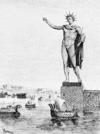- Rhodes, Colossus of
-
Enormous bronze statue of the sun god Helios that towered more than 100 ft (30 m) over the harbour at the city of Rhodes in Greece.The work of Chares of Lindos, the statue commemorated the raising of Demetrios Poliorcetes' long siege of Rhodes (305–304 BC). One of the Seven Wonders of the World, it was toppled by an earthquake с 225 BC. The fallen Colossus was left in place until AD 653, when raiding Arabs broke up its remains and sold the bronze for scrap.
 Colossus of Rhodes, constructed c. 292–280 BC, wood engraving reconstruction by Sidney ...Historical Pictures Service, Chicago
Colossus of Rhodes, constructed c. 292–280 BC, wood engraving reconstruction by Sidney ...Historical Pictures Service, Chicago* * *
▪ statue by Charescolossal (World Heritage site) statue of the sun god Helios that stood in the ancient Greek city of Rhodes and was one of the Seven Wonders of the World. The sculptor Chares of Lyndus (Chares of Lindos) (another city on the island) created the statue, which commemorated the raising of Demetrius I Poliorcetes' long siege (305 BC) of Rhodes. Made of bronze and reinforced with iron, it was weighted with stones. The Colossus was said to be 70 cubits (105 feet [32 metres]) high and stood beside Mandrákion harbour, perhaps shielding its eyes with one hand, as a representation in a relief suggests. It is technically impossible that the statue could have straddled the harbour entrance, and the popular belief that it did so dates only from the Middle Ages.The statue, which took 12 years to build (c. 294–282 BC), was toppled by an earthquake about 225/226 BC. The fallen Colossus was left in place until AD 654, when Arabian forces raided Rhodes and had the statue broken up and the bronze sold for scrap. Supposedly, the fragments totaled more than 900 camel loads.* * *
Universalium. 2010.
